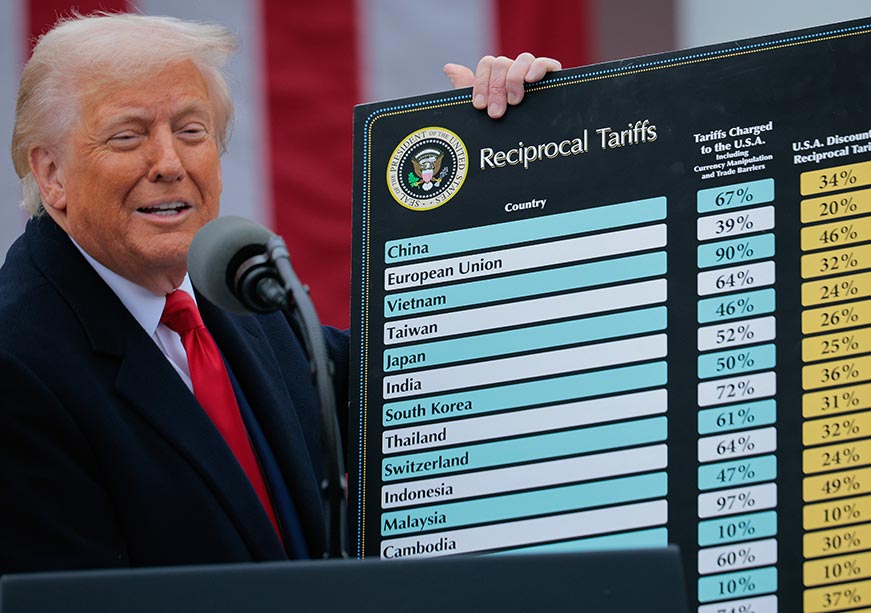-
CENTRES
Progammes & Centres
Location
Trump’s sweeping tariffs mark a hard reset of the US global trade—upending alliances, deepening the China clash, and shaking the foundations of globalisation

Image Source: Getty
The United States (US) President Donald Trump’s ‘Liberation Day’ call for across-the-board tariffs on allies, friends, and partners indicates certain and uncertain elements within his policy arc. While uncertainty characterises the inherent nature of his second term with markets bearing the frontline impact of frequent policy changes from Washington, the latest tariff announcements on 2 April 2025 have added a degree of certainty in policy direction. At least three broad indications have characterised the Trump administration’s foreign policy until now.
First, a coercive economic policy with tariffs as Washington’s cudgel will be used to enforce a tariff parity with trading partners regardless of their strategic proximity to the US. Towards this, one of the primary persuasions for a renewed approach from Trump in his second term is to compel companies to set up manufacturing in the US and, in turn, bring home capital, reducing government expenditure and borrowings. Second, for Trump, the route to America’s greatness is through manipulative economics in which self-interest remains predominant. Third, America’s reorientated approach to global geopolitics is nakedly mercantilist. It is guided by the belief that self-interest led by a principle of net-economic gain alone should guide Washington’s relationships henceforth in a world, where the US’ strict compartmentalisation and gradation of relationships in friends, partners, and allies is increasingly blurred. Perhaps, most importantly, there are no enemy countries in the Trumpian world so long as a deal can be struck.
The sudden barrage of policy reversals from Washington has had countries scrambling to adapt, think over a response, and prepare for the proverbial day after. The wild anticipation that built up to Trump’s ‘Liberation Day’ tariffs declared on 2 April kept markets across the globe on tenterhooks. The markets were sent into a tizzy when the US announced their varyingly high tariffs for several countries. Trump deliberately announced these tariffs after the markets closed on 2 April. As expected, the next day markets opened with global stocks plunging. Standard and Poor’s (S&P’s) lost over 500 points in its worst rout since June 2020. As estimations of Trump’s tariffs have unravelled since they were announced, measures of inflation, supply chain restructuring, global economic slowdown, and a global rush for the dollar have all converged.
The US has lacked the incentive to boost manufacturing capacity at home, resulting in the lack of critical supply chains and increasing dependencies in these areas in countries such as China.
At the heart of Trump’s tariffs is the belief that the US has been at the receiving end of a persistent trade deficit for years, creating an asymmetric and accepted order of disadvantage leading to a ‘hollowing out’ of manufacturing bases in the US. As a result, the US has lacked the incentive to boost manufacturing capacity at home, resulting in the lack of critical supply chains and increasing dependencies in these areas in countries such as China. Following his earlier template of addressing America’s problems through executive actions, Trump invoked the International Emergency Economic Powers Act of 1977 (IEEPA) to address trade deficits with different countries. Using his powers under the IEEPA, Trump invoked a national emergency to levy a baseline tariff of 10 percent on all countries to go into effect on 5 April and a separate set of individualised reciprocal tariffs on countries that the US runs the highest trade deficits with. Leading this chart is, of course, China which was slapped by a 34 percent tariff on an already existing 20 percent. Resultantly, Chinese goods entering the US will be charged 54 percent. Among a wide-ranging list of 57 countries and blocks, Trump’s latest salvo included– the European Union (EU) at 20 percent, Vietnam at 46 percent, Japan at 24 percent, India at 27 percent, South Korea at 26 percent, Thailand at 37 percent, and Switzerland at 32 percent.
While the full impact of Trump’s tariffs is far from being understood with countries still studying the full-spectrum impact before framing their response, estimations on global response can be made from the broad trends of Trump’s tariff policy, which are obvious. Competitive geopolitical relations, an existing trade war from earlier administrations, the highest percentage of tariffs on China, and a large trade surplus with the US have led to China announcing retaliatory tariffs. Successive administrations since Trump’s first term have escalated the trade war with China, fuelling a cycle of retaliatory tariffs. Not surprisingly, China has retaliated with a 34 percent tariff against the US besides backlisting 11 American companies as ‘unreliable entities’ and barring them from doing business in China or with Chinese companies.
Successive administrations since Trump’s first term have escalated the trade war with China, fuelling a cycle of retaliatory tariffs.
In the coming months—and possibly years—the first-order impact on markets, connectivity, investments, and regional geopolitics will stem from the unfolding trade war between the US and China, as other economies rework their long-term partnerships in trade towards stability. With the total trade between the US and China being over US$ 580 billion, repercussions of an all-out trade war will be massive, especially on supply chains and the global dollar reserve. The escalating trade war has the potential to rapidly widen the divide between the two leading world economies and powers, considering their respective policy focuses are opposites. More worryingly, the Trump administration’s approach to energy, climate, technology, Electric Vehicles (EVs), and critical and emerging minerals starkly contrast China’s approach.
Beyond China, the US tariffs might compel other major trading partners to readjust to the tariffs and redirect their sectoral supply chains in some cases. The recently announced joint outlook to respond to US tariffs by China, Japan, and South Korea may be a glimpse into how countries are already readjusting. However, the approach of other countries in coping could be significantly different, with smaller countries like Cambodia, Bangladesh, Myanmar, Sri Lanka, Vietnam, and others expected to face an impact much worse than larger economies, where it is expected to be much higher.
There have been complimentary signals from Delhi and Washington in laying grounds for a non-confrontationist trade readjustment between the two sides.
India’s response to the US tariffs has been measured so far. Unlike the last Trump administration, India’s response to the US tariffs will be calibrated because the two sides are engaged in ongoing trade talks. Trump’s warning that any retaliation will lead to a cycle of escalation is also likely to temper responses from countries hit by America’s tariffs. Besides, there have been complimentary signals from Delhi and Washington in laying grounds for a non-confrontationist trade readjustment between the two sides. India signalled a positive approach to engaging America through conciliatory steps in certain import sectors in its Union Budget in 2025. Trump moderated the India tariffs from an initial 27 percent to 26 percent, calling it a ‘discounted’ reciprocal tariff for India. Given the vast trade surplus of India over the US amounting to more than US$ 45 billion in 2024, a 26 percent tariff may still be a huge revenue loss for India. Nonetheless for India, the unravelling trade war by Trump may offer two advantages: First, India may not be in the direct crosshairs of Trump-like China. Second and more importantly, Trump has already hinted that he is open to negotiations on tariff numbers. Still, India’s response will not be limited to absorbing the tariffs from the US.
Meanwhile, as the broader Global South goes into a tailspin, countries including India will not base the broader plank of their economic policies on an increasingly uncertain US. Rules of basic economics are likely to work in market and supply chain restructuring, especially as the world’s second-largest economy China will look to find newer markets across South, Central, and Southeast Asian regions. Needless to say, the accompanying geopolitics might change the connectivity labyrinth of the Indo-Pacific. The US-China trade war should not be seen as a template for other countries’ reaction to US tariffs simply because of the trade value and sectors, which could differ significantly for specific countries. Smaller countries which have been highly tariffed and have a greater reliance on the US for imports like Vietnam, Cambodia, and Bangladesh will be watched with anticipation.
Although the Global South stands vindicated in its sceptical assumptions about the Liberal World Order, a stable and sustained economic policy from the West did help lift millions out of poverty in many countries, over the last seven decades.
Trump’s economic reordering may be sounding a death knell for the last century’s premise of a globalised world order, which was governed by an agreed set of principles and global institutions. The post-World War II institutions like the United Nations Organization, World Trade Organization and the International Monetary Fund, although inherently framed to favour the West over the rest, did have some virtues. Although the Global South stands vindicated in its sceptical assumptions about the Liberal World Order, a stable and sustained economic policy from the West did help lift millions out of poverty in many countries, over the last seven decades. China was the largest benefactor of that change. That era may now be turning once and for all.
Vivek Mishra is Deputy Director of the Strategic Studies Programme at the Observer Research Foundation.
The views expressed above belong to the author(s). ORF research and analyses now available on Telegram! Click here to access our curated content — blogs, longforms and interviews.

Vivek Mishra is Deputy Director – Strategic Studies Programme at the Observer Research Foundation. His work focuses on US foreign policy, domestic politics in the US, ...
Read More +